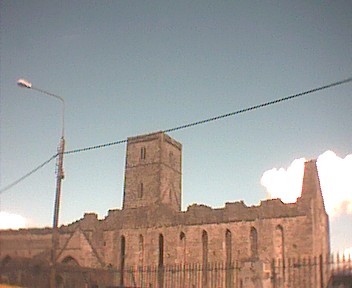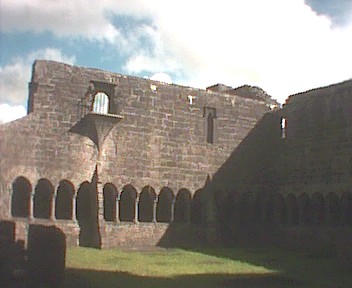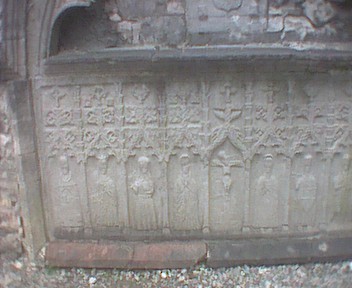



Sligo Abbey is in a busy town centre, and is the first, and so far only, old religious house I have been to that charges admission... Most are deep in the countryside.... So it has a Visitors' Centre and a lot of information. And is, in summer, busy with, as T.S . Eliot expresses it in "Murder in the Cathedral, speaking about Canterbury , " tourists with guide-books looking over it."
Mostly Americans, in Ireland seeking their roots.
It was founded in 1252 0r 1253 by Maurice Fitzgerald, who also founded Sligo Town. And was in fact a Dominican Friary. The leaflet expresses the difference as follows. "‘Friar preachers' reside in a friary, whereas ‘monks' live in an abbey. Friars invited the public to worship in their church and went on preaching pilgrimages. In contrast, public access to abbeys was restricted and monks generally confined their vocation to worship through prayer and meditation."
These definitions overlap, of course, but it explains the location in the town centre, rather than out in the country; town friars needed not to grow their own food......
One of the photos I took shows the O'Connor Sligo monument of 1642, built into the south wall of the choir. This commemorates Sir Donagh O'Connor, Lord of Sligo, and his wife, Lady Elinor Butler... They kneel in devout pose within a triumphal arch housing. Renaissance symbolism and symmetry
govern the decorative elements, and features include..crucifixion with
saints, coat of arms and symbols of death and the afterlife. It was O'Connor's influence with Queen Elizabeth which saved Sligo friary from dissolution, a fate suffered by a majority of the Irish catholic religious houses in the 16th century...
See Moyne and Rosserk.. And Creevelea... and many others...
So the secular saves and supports the religious. And thus is honoured.
But.... the British have an appalling record in this country.....
The friary suffered much damage over the centuries. In 1642, the armies of Sir Frederick Hamilton, a Cromwellian soldier, attacked Sligo Town, causing significant damage to the friary. An edict of banishment was imposed on the friars in 1698 when the property was seized under the agency of the Crown.
And not just the British....
In the early 18th century, a local merchant named Thomas Corcoran, quarried the friary for building materials to construct town houses nearby. Despite all this, the friars were in residence up unto the 1760s, after which they relocated to another friary nearby and the Order is still in town today.
Another fine carving is the O'Crean monument ( see photos). Dated 1506, it is decorated in typical medieval style. It has a peaked canopy with ornate tracery. The tomb chest is carved with figures beneath cusped arches and floral ornament. From left to right..St Dominic, St Catherine ( with sword and wheel), a female saint(?), the Virgin Mary, the Crucifixion, St John, St Michael the Archangel( with sword and wings), St Peter( with key) and an Archbishop(?St Patrick?).
And the 15th century stone High Altar is the only sculptured example to survive in any monastic church. The front panelling is finely carved with foliage ornament, grapes and a rose. It is against the wall so the priest would have faced east......
The graveyard history is interesting, especially after Creevelea. It was in continual use as a graveyard throughout its history. Both the grounds and the friary interior became the official town cemetery in the 18th century, and the friary ground level has been raised several feet to accommodate further burials........
It is "interesting" in many ways to have so much detailed information...And to see it well-maintained ( there was work going on there that day) But to see a place of worship, holy ground, become only a secular historical site? Simply wandering at will, I walked the cloisters in reverence, for such are my soul-home. And never spared a thought for architectural features...
Interesting then an encounter - several times - with a young American man. He had come to Ireland with a plan to see all the High Crosses, but had realised that in the time he had, that was an impossible scheme...
I met him again by the High Alter, and we talked. About prayer... he is a non-practising Jew, bored by it all - and by everything, world weary, Seeing this as a place that had "served its purpose"; and that all faith-traditions are the same. Bored, apathetic - and I wondered then why
travel all that way just to see High Crosses?
When he left, I knelt there before that High Altar, where Christ's sacrifice had been so many times over so many centuries, in thus a place sacred for all eternity, and prayed for him for conversion and thus for peace and happiness...........
And in those minutes I knelt there, in a busy, in a thronging town centre, no-one came in and I heard no voices. There was silence and stillness. And, thinking back, that space and that time and that sacredness entered deep within me and coloured my thoughts as I went on my way, shopping. I felt love reaching out to everyone I saw, that deep compassion I know is not of me..
Nothing can take sacredness, holiness away; no human agency, no tourist information. For it is of God, and eternal and indestructible......He and
His love live on and hallow and sanctify every town and street.